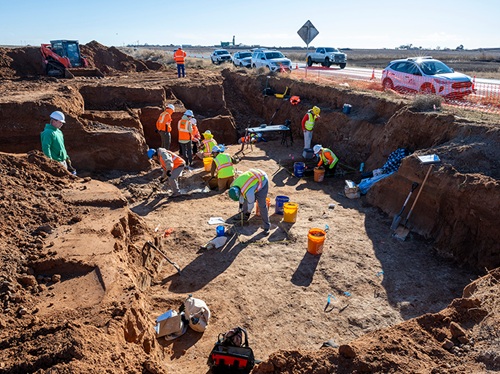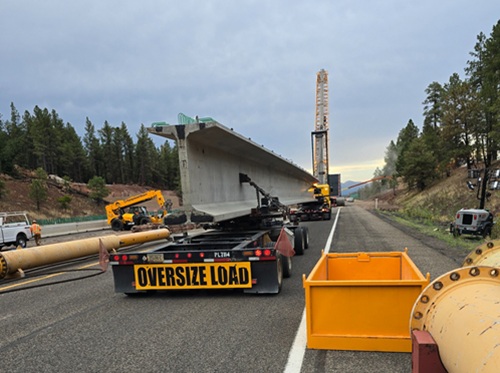During the environmental review for the Loop 88 highway project outside Lubbock, TX, planners with the Texas Department of Transportation made an interesting discovery – and promptly called in one of the agency’s archaeological teams to figure out what they found.
[Above photo by TxDOT]
“They found the bones of some large, prehistoric animals called ‘megafauna,’ which is not unusual in the region,” noted Chris Ringstaff, a project planner with TxDOT’s environmental affairs division, in a recent blog post.
He explained that the Panhandle area of Texas – where Lubbock is located – is home to many “playas” or remnants of lakes from the Ice Age. In prehistoric times, animals and humans used playas as water sources and these sites can sometimes contain evidence of human activity.
“If the site involves humans, we have to address road construction impacts under state and federal law,” Ringstaff said. “If the site has no artifacts and dates to a time well before humans, TxDOT will recommend no further work, and the project can proceed to construction.”
Given that Texas has other sites that show human activity with megafauna, TxDOT decided to take a closer look at the Loop 88 location. They opted for a process called “staged mitigation” that involves archeological excavation to look for human artifacts like chipped stone or spear points.
TxDOT said environmental staff and consulting archeologists excavated bones and took geologic and sediment samples for fine screening, with the agency also collaborating with the Museum of Texas Tech University for assistance with preparation, identification, and housing of the bones.
“We know we’ve found giant ground sloth by its distinctive tooth,” Ringstaff said. “Whether all the bones are giant ground sloth or there are different animals such as mammoth or mastodon, we’re not sure. Paleontologists will give us positive identification.”
Experts are examining the dirt collected around the bones for micro-artifacts and using geologic dating techniques to get a better idea of the chronology of the objects. Should the site reveal human activity with megafauna from the Ice Age, it would be first of its kind for a TxDOT project.
“Excavation is one of many steps we can take prior to road construction to ensure that Texas history is preserved,” added Rebekah Dobrasko, director of TxDOT’s cultural resources section.
Fortunately, even if further excavation is needed, TxDOT said work on the Loop 88 project is still well ahead of any physical construction deadlines – part of its planning work to ensure environmental reviews do not affect a project’s timeline.
“We’re here to get the road built,” Ringstaff said. “But who doesn’t love digging up big ol’ animals?”
Across the country, state departments of transportation are involved in a variety of cultural and archaeological efforts.
For example, in March, the Maryland Department of Transportation showed off a trove of “interesting artifacts” found at the Ben Ross home historical dig site; the place where the father of Civil War-era abolitionist Harriet Tubman lived and where she spent her teenage years in Dorchester County.
The agency said its archaeologists spent the past four years processing hundreds of artifacts collected from the Ross home, which is deep in the wetlands of the Blackwater National Wildlife Refuge.
In August 2024, the North Carolina Department of Transportation – in partnership with N.C. State University’s Institute for Transportation Research and Education – launched a two-year project aimed at mapping unmarked burial sites belonging to historically marginalized groups statewide.
In October 2022, the Kentucky Transportation Cabinet helped establish a new website highlighting more than 100 prehistoric and historic archaeological sites across the state’s 64 counties.
The agency launched that website – Discover Kentucky Archaeology – in collaboration with the Kentucky Heritage Council-State Historic Preservation Office, an agency of the Kentucky Tourism, Arts, and Heritage Cabinet.
And in January 2022, the Colorado Department of Transportation debuted a documentary called “Durango 550 – Path of the Ancestral Puebloans” to show how the agency worked with archaeologists and regional Native American tribes to document, study, and ultimately share the discoveries unearthed near Durango in southwest Colorado.




